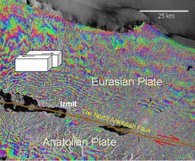Co-seismic Deformation Detection of the Izmit Earthquake with INSAR
A strong earthquake occurred in northwestern Turkey at the eastern extension of the Sea of Marmara at 3:01:48 local time on 17 August 1999. The earthquakes epicenter was located 110 km east of Istanbul, at 40.8°N latitude and 30.1°E longitude, near the town of Izmit on the North Anatolian fault. The earthquake measured 7.5 (moment magnitude) on the modified Richter scale. The tectonic activity in the area is basically explained by movements of the Eurasian, Arabic and African plates activating different portions of the Anatonian fault system. The Izmit earthquake originated at a depth of between 10 and 16 km along almost vertical ruptures. The surface displacement reached a maximum of 5 m near the town Arifiye. The average offset along the active fault was 2 to 4 m.
To obtain the quantitative co-seismic deformation caused by the Izmit earthquake a data pair of ERS-1, orbit 42229 frame 0819 date 08/12/1999 and orbit 42730 frame 0819 date 09/16/1999, was used for interferogram generation (see Fig. 1). Because of a very small baseline of the data pair the fringes in the interferogram represent only the surface displacement. The influence of the ground topography in the interferogram becomes negligible. Each fringe (color cycle) corresponds to a ground displacement of 2.8 cm in satellites viewing direction (slant range). It should be noted that the phase gradient in the northern side of the fault is pointing to the fault, but in the southern side is apart from the fault. This means that the earthquake ruptured the fault. The northern (Eurasian plate) of the fault was moved to east, the southern (Anatolian plate) of the fault was moved to west. In the interferogram, 24 fringes can be observed in both side of the fault. The 24 fringes represent a slip of 72 cm in slant range or 1.84 m in ground direction. Thus the relative offset of the fault was 3.68 m. This result from INSAR agrees with the conducted ground measurements.


